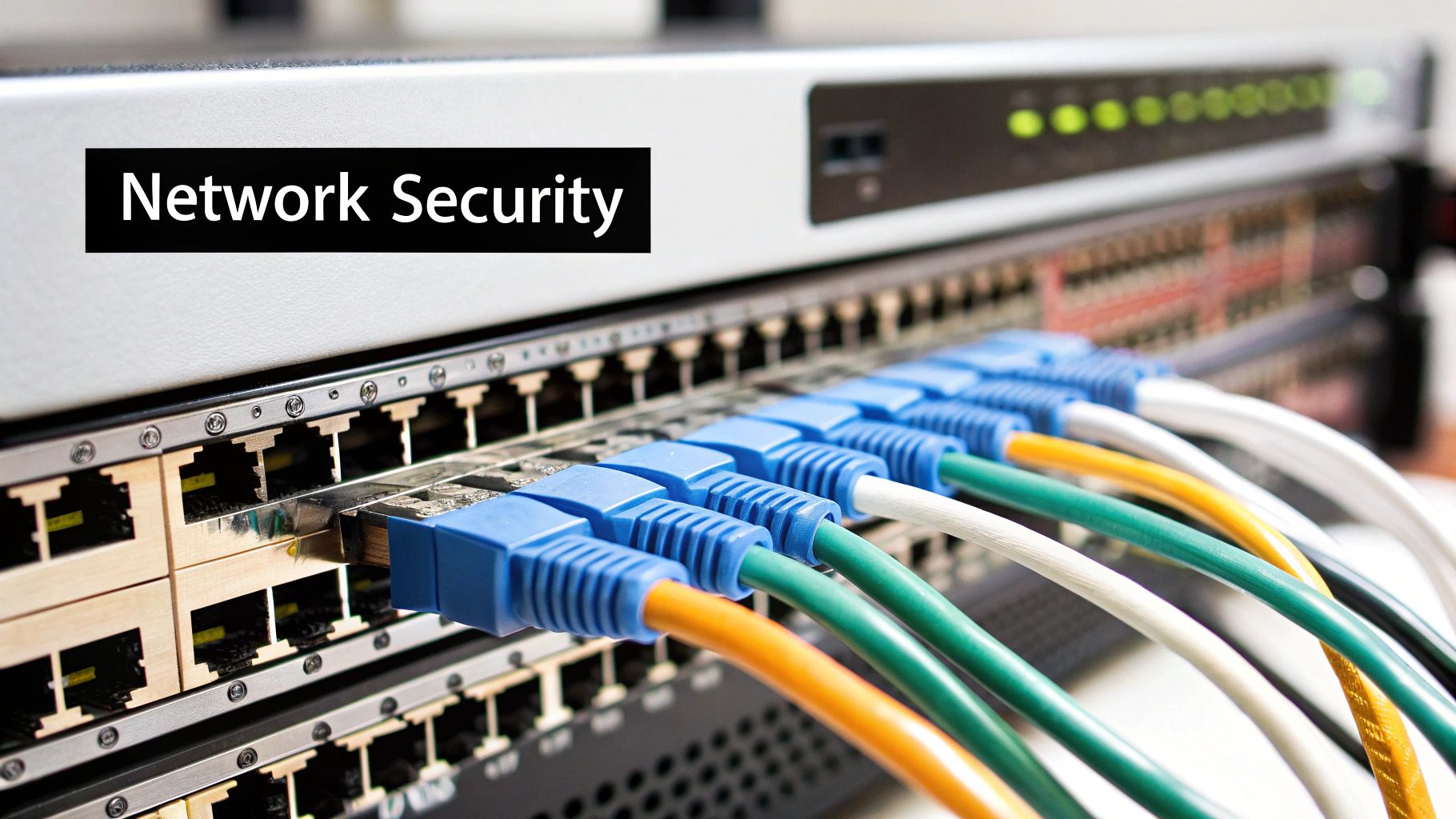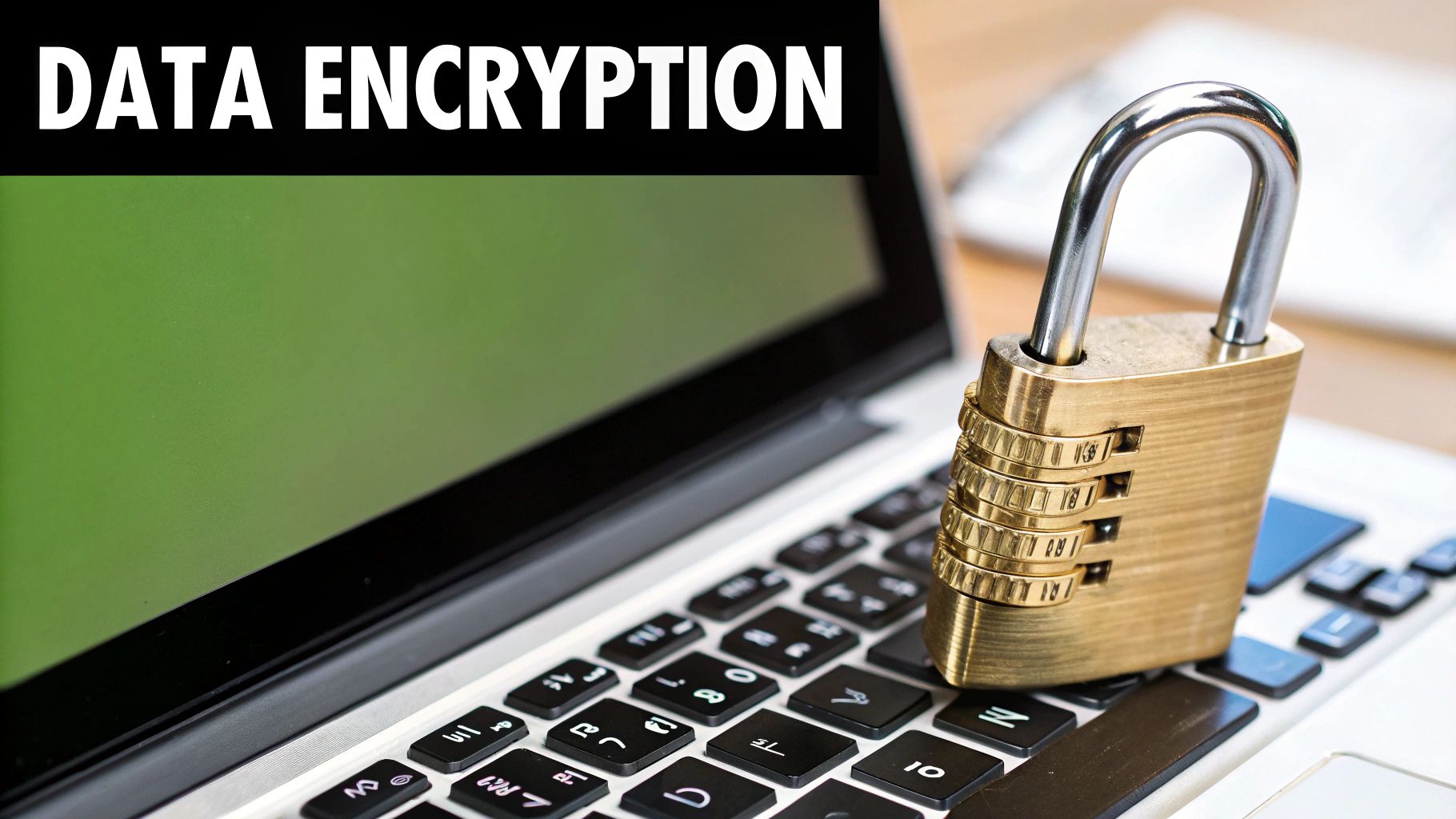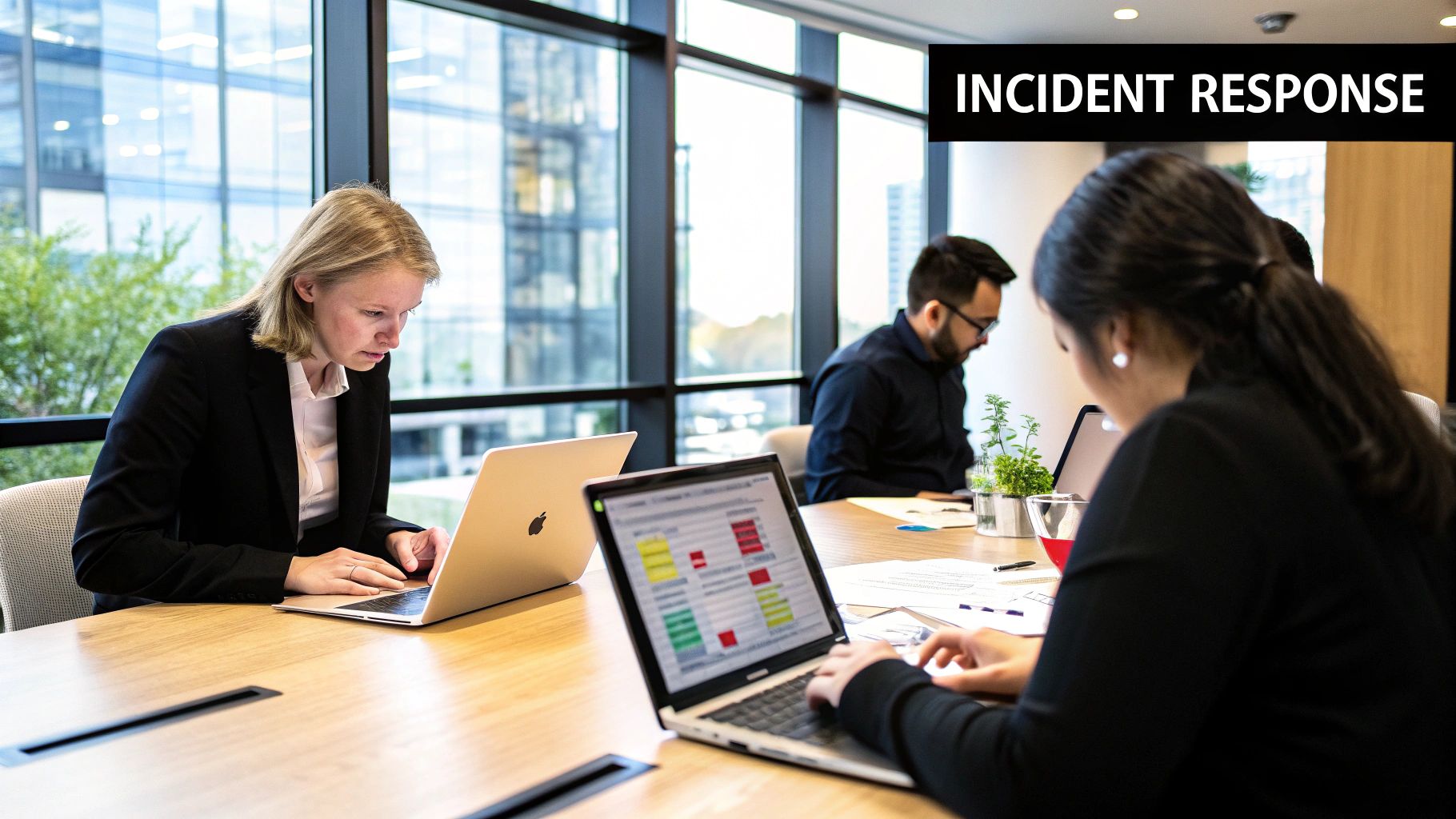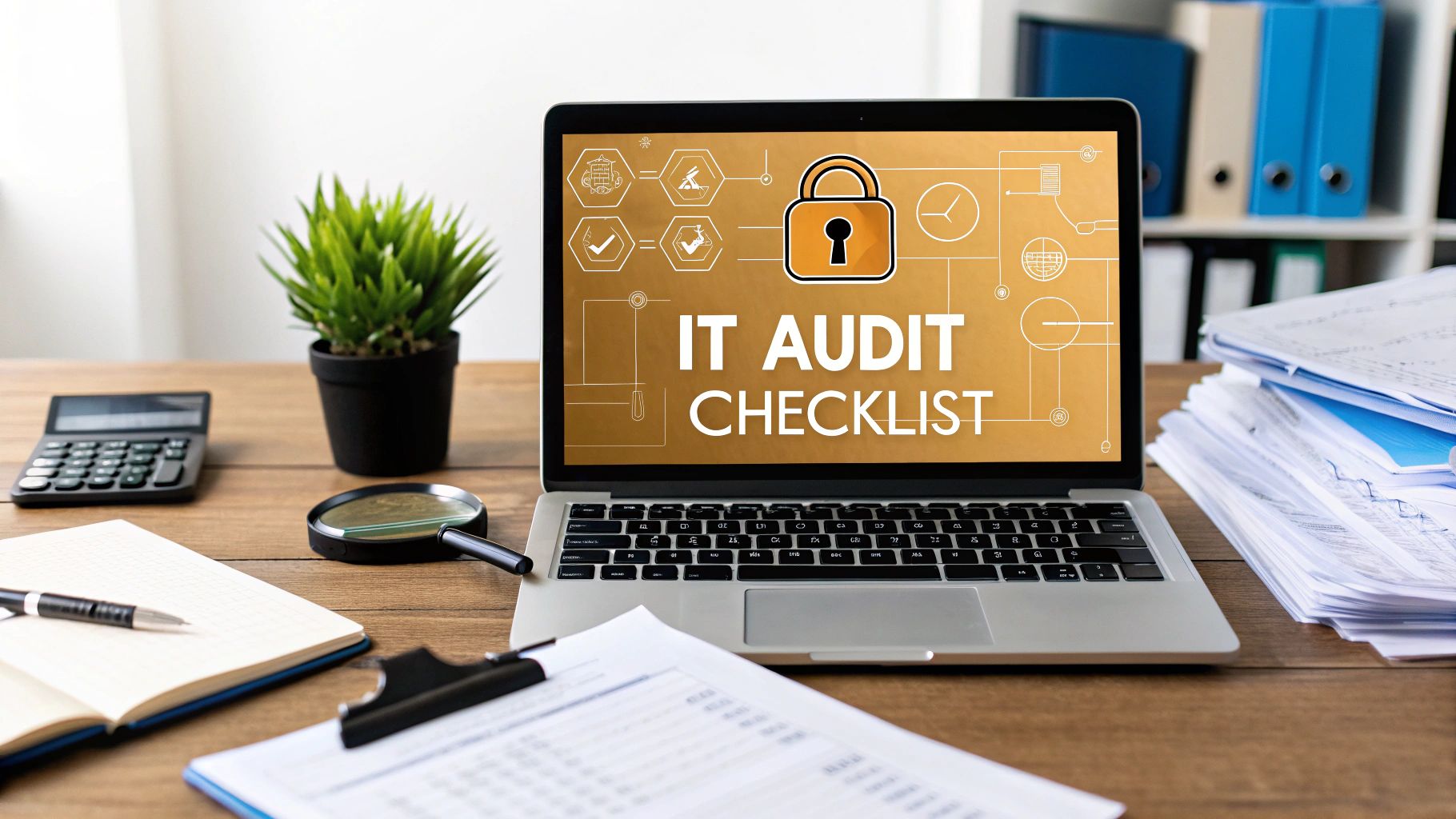Waiting for a security breach to happen is not a strategy, it’s a liability. An IT security audit is a proactive, systematic evaluation of your organization’s security posture. It is not just about ticking boxes for compliance; it is about uncovering hidden vulnerabilities before malicious actors do. This comprehensive it security audit checklist is designed to guide you through the critical domains of your technology infrastructure, from access controls and network configurations to third-party vendor risks.
By methodically assessing these core areas, you can build a resilient security framework that genuinely protects sensitive data and ensures operational continuity. For any business, especially those managing customer data and physical access like in hospitality, multi-family housing, and retail, a rigorous audit is the foundation of a secure and reliable service. A strong defense is built on understanding your weaknesses, and that process begins with a thorough, structured review.
This guide moves beyond generic advice to provide a detailed, actionable roadmap. You will learn how to scrutinize eight essential security domains:
- Access Control and Identity Management
- Network Security Configuration
- Data Protection and Encryption
- Vulnerability Management Program
- Incident Response and Business Continuity
- Security Awareness and Training Program
- Compliance and Regulatory Adherence
- Third-Party Risk Management
Each section will offer specific verification points and practical examples to help you implement changes immediately. Let’s dive into the essential checklist items you must scrutinize to fortify your defenses and safeguard your assets.
1. Access Control and Identity Management
At the core of any robust IT security audit checklist is a rigorous evaluation of Access Control and Identity Management (IAM). This process examines who has access to your digital assets, what they can do with that access, and how their identity is verified. A thorough audit here ensures that only authorized individuals can access sensitive information, thereby preventing both malicious attacks and accidental data breaches. It is the digital equivalent of ensuring only the right people have the right keys to the right rooms in your facility.
The primary goal is to enforce the principle of least privilege, a foundational security concept stating that users should only be granted the minimum levels of access, or permissions, needed to perform their job functions. This minimizes the potential damage from a compromised account. An effective audit will scrutinize everything from how a new employee gets their initial login to how their access is revoked upon departure.

Why It’s a Critical Audit Point
Weak access controls are a primary vector for security incidents. Without a systematic approach to managing identities, organizations are vulnerable to former employees retaining access, current employees accumulating unnecessary permissions, and attackers easily escalating privileges once inside the network. A comprehensive audit of your IAM policies is not just a best practice; it is often a mandatory requirement for compliance with regulations like HIPAA, PCI DSS, and GDPR.
Actionable Audit Steps & Best Practices
To effectively audit your access controls, focus on these key areas:
- User Access Inventory: Begin by creating a complete inventory of all user accounts across all systems, including applications, servers, and network devices. This list should be cross-referenced with HR records to identify any orphaned or unauthorized accounts.
- Provisioning and Deprovisioning: Review your procedures for creating and deleting user accounts. Implement automated workflows to ensure access is granted promptly upon hiring and, more importantly, revoked immediately upon termination. For example, integrating your HR system with Active Directory can automate this process.
- Privilege and Role Review: Scrutinize the permissions assigned to each user and role. Are they aligned with the principle of least privilege? Regularly schedule reviews (at least quarterly) with department managers to re-certify that each user’s access rights are still appropriate for their current role.
- Authentication Mechanisms: Verify that strong authentication methods are enforced. This includes checking for password complexity requirements, password expiration policies, and the widespread implementation of Multi-Factor Authentication (MFA), especially for remote access and access to sensitive systems.
- Documentation: Ensure all access control policies and procedures are clearly documented and accessible. This documentation is crucial for training, consistency, and demonstrating compliance to auditors.
2. Network Security Configuration
Following access control, the next crucial pillar in a comprehensive IT security audit checklist is the evaluation of your Network Security Configuration. This involves a deep dive into the architecture and safeguards protecting your entire network infrastructure. An audit in this area assesses firewall rules, network segmentation strategies, the effectiveness of intrusion detection/prevention systems (IDS/IPS), and the enforcement of secure network protocols. The goal is to ensure your network is a well-defended fortress, not an open highway for attackers.
A properly configured network acts as the first line of defense, controlling the flow of data and shielding critical assets from unauthorized access and cyber threats. This audit verifies that your network’s design and its active security measures are correctly implemented, actively monitored, and aligned with current security best practices. Industry leaders like Palo Alto Networks have championed concepts such as zero-trust network architecture, where no user or device is trusted by default, demonstrating the shift towards more proactive network defense.

Why It’s a Critical Audit Point
A misconfigured network is one of the most common and dangerous vulnerabilities an organization can have. Gaps in firewall rules, flat network architecture, or a lack of traffic monitoring can allow attackers to move laterally across your systems with ease once they gain an initial foothold. Auditing your network configuration is vital for preventing data breaches, ensuring business continuity, and meeting compliance standards like PCI DSS, which has strict requirements for network segmentation and firewall management.
Actionable Audit Steps & Best Practices
To conduct a thorough audit of your network security configuration, concentrate on these essential actions:
- Firewall Rule and Policy Review: Methodically review every firewall rule to ensure it serves a legitimate business purpose and follows the principle of least privilege. Remove any outdated, redundant, or overly permissive “any-any” rules. Document the justification for each rule and schedule regular reviews (at least semi-annually).
- Network Segmentation Verification: Confirm that your network is segmented into distinct security zones based on data sensitivity and function (e.g., separating guest Wi-Fi from the corporate network, and production servers from development environments). This contains potential breaches within a smaller area. For example, financial institutions often use robust segmentation, a strategy perfected by providers like Cisco, to isolate cardholder data environments.
- Device and Protocol Audit: Use network discovery tools to create a complete inventory of all connected devices and validate that no unauthorized devices are on the network. Scrutinize the protocols in use and disable insecure ones like Telnet or unencrypted FTP, replacing them with secure alternatives like SSH and SFTP.
- Intrusion Detection and Monitoring: Verify that your IDS/IPS is properly configured and actively monitoring traffic for suspicious activity. Your audit should check that alerts are being generated, reviewed, and acted upon promptly. Effective network security depends on both prevention and detection, and you can explore more on this topic by reviewing key network monitoring best practices.
- Implement Network Access Control (NAC): Audit or implement a NAC solution to enforce security policies on devices before they are granted network access. NAC can check for up-to-date antivirus software, required patches, and proper configurations, blocking non-compliant devices from connecting.
3. Data Protection and Encryption
A fundamental pillar of any comprehensive IT security audit checklist is the stringent assessment of Data Protection and Encryption. This involves evaluating the entire lifecycle of your sensitive data: how it’s classified, protected while stored (data at rest), secured during transmission (data in transit), and properly destroyed at its end of life. An effective audit in this area ensures that even if access controls fail, the underlying data remains unreadable and unusable to unauthorized parties, safeguarding confidentiality and integrity.
The core objective is to apply robust cryptographic protections to your most valuable digital assets. This goes beyond simply having encryption; it requires a holistic strategy that includes strong algorithms, secure key management, and consistent policy enforcement. Think of it as placing your critical documents in a state-of-the-art safe (encryption) and tightly controlling who has the combination (key management).

Why It’s a Critical Audit Point
In today’s data-driven world, data is often an organization’s most valuable asset. A breach that exposes customer, financial, or proprietary information can lead to devastating financial loss, reputational damage, and severe regulatory penalties under laws like GDPR, CCPA, and HIPAA. Auditing your data protection measures is non-negotiable for mitigating these risks. It verifies that your security controls are not just theoretical but are effectively implemented and resilient against real-world threats.
Actionable Audit Steps & Best Practices
To conduct a thorough audit of your data protection and encryption, concentrate on these specific areas:
- Data Classification: Review your data classification policy. Verify that a system is in place to categorize data based on sensitivity (e.g., Public, Internal, Confidential, Restricted). This is a crucial first step, as you cannot effectively protect what you have not identified and valued.
- Encryption at Rest and in Transit: Audit all critical systems to confirm that sensitive data is encrypted at rest. This includes databases (like using Microsoft’s Always Encrypted feature in SQL Server), file servers, and backups. Simultaneously, verify that data is encrypted in transit using strong protocols like TLS 1.2+ for all network communications.
- Key Management: Scrutinize your encryption key management procedures. Who generates, stores, rotates, and revokes keys? For high-security needs, verify the use of Hardware Security Modules (HSMs) to protect master keys from both physical and logical attacks.
- Data Loss Prevention (DLP): Evaluate your DLP solutions. Check the rules and policies that monitor and block unauthorized exfiltration of sensitive data via email, USB drives, or cloud uploads. Test to ensure alerts are being generated and responded to correctly.
- Backup and Disposal: Confirm that your data backups are encrypted and stored securely, ideally in a geographically separate location. Crucially, test your backup restoration process regularly. Also, review and verify your data disposal and media sanitization procedures to ensure data is irretrievably destroyed when no longer needed.
4. Vulnerability Management Program
A cornerstone of any comprehensive IT security audit checklist is the evaluation of the Vulnerability Management Program. This is not a one-time task but a continuous, cyclical process of identifying, assessing, prioritizing, and remediating security weaknesses across all IT assets. A mature program involves regular vulnerability scanning, a defined patch management process, and periodic penetration testing. It serves as your organization’s proactive defense, finding and fixing security holes before attackers can exploit them.
The ultimate goal is to systematically reduce your organization’s attack surface. By continuously monitoring for new vulnerabilities, you can maintain a strong security posture against evolving threats. A well-executed program moves an organization from a reactive, “fire-fighting” mode to a proactive state of security readiness, treating vulnerability remediation as a standard operational procedure.
Why It’s a Critical Audit Point
Neglecting vulnerability management is like leaving your doors and windows unlocked. New vulnerabilities are discovered daily in common software and hardware, and cybercriminals actively scan for unpatched systems to exploit. An audit of your vulnerability management program verifies that you have a structured and effective process to close these security gaps promptly. Without it, your organization remains low-hanging fruit for automated attacks and targeted intrusions, and will likely fail compliance audits for standards like PCI DSS and HIPAA.
Actionable Audit Steps & Best Practices
To properly audit your vulnerability management program, concentrate on these essential components:
- Asset Inventory and Discovery: Verify that a complete and accurate inventory of all network assets (servers, workstations, firewalls, applications) exists. Your audit should confirm that vulnerability scans cover 100% of this inventory to ensure no systems are missed.
- Scanning and Identification: Review the frequency and configuration of your vulnerability scans. Are you using authenticated scans for deeper insights? Are you using industry-standard tools like those from Tenable, Qualys, or Rapid7? Check scan reports to see how vulnerabilities are being identified.
- Risk-Based Prioritization: Assess how vulnerabilities are prioritized for remediation. The audit should confirm you are using a risk-based approach, often leveraging the Common Vulnerability Scoring System (CVSS), and not just fixing the easy ones first. Prioritize vulnerabilities on critical assets or those that are actively being exploited in the wild.
- Remediation and Patching: Examine your patch management process. Are there defined Service Level Agreements (SLAs) for fixing vulnerabilities based on severity (e.g., critical flaws fixed in 15 days, high in 30)? Look for evidence of automated patch deployment where feasible and verify that remediation is tracked and confirmed with follow-up scans. For organizations seeking specialized expertise, exploring managed security solutions can provide the necessary support for a robust program.
- Reporting and Metrics: Check that the program generates clear, actionable reports for both technical teams and executive leadership. Key metrics to audit include Mean Time to Remediate (MTTR), scan coverage percentage, and the number of open critical vulnerabilities over time.
5. Incident Response and Business Continuity
A critical part of any IT security audit checklist is evaluating your organization’s resilience in the face of a crisis. This involves a deep dive into your Incident Response (IR) and Business Continuity Planning (BCP). This audit area assesses your ability to not only detect and contain a security incident, such as a ransomware attack or data breach, but also to recover from the disruption and maintain core business operations. It’s about having a tested plan to get back on your feet when the worst happens.
The ultimate goal is to minimize downtime, financial loss, and reputational damage following an incident. A robust plan ensures that chaos is replaced with a clear, coordinated, and effective response. The audit will scrutinize every stage, from the initial alert to post-incident analysis, ensuring the organization can withstand significant operational stress. For example, Maersk’s recovery from the devastating NotPetya ransomware attack in 2017 hinged on their ability to rapidly restore systems from the few available offline backups, a testament to the importance of a resilient recovery strategy.

Why It’s a Critical Audit Point
An organization without a tested incident response plan is like a ship without lifeboats. When a security event occurs, the difference between a minor issue and a full-blown catastrophe is often the speed and effectiveness of the response. Auditing your IR and BCP capabilities verifies that you can protect your assets and stakeholders when an active threat materializes. This is essential for maintaining customer trust and meeting compliance requirements that mandate formal incident handling procedures.
Actionable Audit Steps & Best Practices
To conduct a thorough audit of your incident response and business continuity plans, concentrate on these specific areas:
- Plan and Playbook Review: Examine your documented Incident Response Plan. Does it clearly define roles, responsibilities, and communication protocols? Check for detailed “playbooks” for specific scenarios like ransomware, DDoS attacks, and data breaches. Ensure contact lists for internal teams, external experts, and legal counsel are up-to-date.
- Testing and Simulation: A plan on paper is not enough. Verify that regular testing is conducted. This includes tabletop exercises where teams talk through a simulated incident and full-scale simulations that test technical and procedural responses. Review the outcomes of these tests to see if they led to meaningful improvements.
- Backup and Recovery Systems: Audit your backup strategies rigorously. Confirm that critical data is backed up regularly, that backups are stored securely (including offline or air-gapped copies), and most importantly, that they are tested for successful restoration. This is a core component of any effective recovery strategy, as outlined in this comprehensive disaster recovery checklist on clouddle.com.
- Post-Incident Analysis: Check the process for learning from past incidents. The audit should find evidence of a “lessons learned” or post-mortem process after every security event, no matter how small. This documentation should show how findings were used to update security controls, policies, and the response plan itself to prevent recurrence.
6. Security Awareness and Training Program
Even the most advanced technical defenses can be rendered useless by a single, uninformed click from an employee. This is why a thorough evaluation of your Security Awareness and Training Program is a non-negotiable part of any modern IT security audit checklist. This audit point assesses how effectively your organization educates its team about cybersecurity threats, policies, and best practices. It’s about transforming your workforce from a potential vulnerability into your first line of defense.
The core objective is to cultivate a security-conscious culture, where every employee understands their role in protecting the organization’s digital assets. An audit in this area goes beyond simply checking if training was completed; it measures the program’s actual impact on employee behavior and overall risk reduction. Companies like KnowBe4 and Proofpoint have built entire platforms around the principle that a well-trained workforce is a critical security layer.
Why It’s a Critical Audit Point
Human error remains a leading cause of security breaches, with phishing attacks, social engineering, and accidental data exposure costing businesses millions. A robust training program directly mitigates these human-centric risks. Without consistent, engaging education, employees are more likely to fall for scams, use weak passwords, or mishandle sensitive data. Auditing your program ensures it is not just a “check-the-box” compliance activity but a dynamic and effective tool for risk management.
Actionable Audit Steps & Best Practices
To audit your security awareness program effectively, concentrate on these key areas:
- Training Content and Relevance: Review the training materials to ensure they are current, engaging, and relevant to the specific threats your organization faces. For instance, training for the finance department should emphasize risks like business email compromise (BEC), while developers need training focused on secure coding practices.
- Phishing Simulations: Verify that regular, unannounced phishing simulations are being conducted. Audit the results to track click rates, reporting rates, and overall improvement over time. The goal is to see a steady decrease in vulnerability and an increase in proactive reporting.
- Effectiveness Measurement: Assess how the program’s effectiveness is measured. Look for metrics beyond simple completion rates. Effective programs track behavioral changes, such as the number of employees reporting suspicious emails or a reduction in help-desk tickets for password resets due to improved habits.
- Ongoing Reinforcement: An audit should confirm that security awareness is not a one-time event. Look for evidence of continuous reinforcement through newsletters, security tips in team meetings, posters, and recognition for employees who demonstrate good security practices.
- Policy Acknowledgment: Check that there is a formal process for employees to read and acknowledge key security policies, such as the acceptable use policy and data handling procedures. This should be tracked and documented, creating a clear audit trail.
7. Compliance and Regulatory Adherence
Navigating the complex landscape of legal and industry-specific regulations is a non-negotiable part of modern IT security. This component of an IT security audit checklist involves a systematic review to ensure your organization’s practices, controls, and documentation meet the requirements of all applicable laws and standards. It’s about more than just avoiding fines; it’s about demonstrating a commitment to protecting sensitive data and maintaining trust with clients and partners.
The core objective is to map your existing security controls against the specific mandates you are subject to, identifying any gaps and creating a plan for remediation. Whether you are a healthcare provider handling patient records or a retailer processing credit cards, a failure in compliance can lead to severe financial penalties, reputational damage, and legal action. This audit point ensures your security posture is not only technically sound but also legally defensible.
Why It’s a Critical Audit Point
Compliance is not an optional extra; it is a fundamental business requirement enforced by governing bodies. Non-compliance can halt business operations, trigger costly mandatory breach notifications, and erode customer confidence. For instance, a healthcare organization must demonstrate adherence to HIPAA to protect patient data, while any business handling data of EU citizens must comply with GDPR’s strict data protection principles. An audit confirms that your documented policies are actually being followed in practice.
Actionable Audit Steps & Best Practices
To effectively audit your compliance and regulatory adherence, concentrate on these crucial activities:
- Identify Applicable Regulations: First, create a definitive list of all regulations and standards your business must comply with. This could include HIPAA for healthcare, PCI DSS for financial transactions, GDPR for data privacy in the EU, or SOX for public companies’ IT controls.
- Map Controls to Requirements: For each regulation, map your current security controls to its specific requirements. For example, document how your encryption and access control policies satisfy a particular PCI DSS requirement. This creates a clear compliance matrix.
- Review Documentation and Evidence: An audit is about proof. Gather and review all relevant documentation, such as policies, procedures, risk assessments, training records, and system logs. Ensure you have readily available evidence, like audit trails, to demonstrate that controls are operating effectively.
- Conduct Gap Analysis: Use the compliance matrix to perform a gap analysis, identifying areas where controls are missing, insufficient, or not properly documented. Prioritize these gaps based on the associated risk and regulatory importance.
- Stay Current with Changes: Regulations evolve. Establish a process for monitoring and integrating changes to relevant laws and standards into your security program. A compliance calendar can help track key dates for reporting and re-certification.
8. Third-Party Risk Management
An organization’s security perimeter no longer ends at its own network firewall. A crucial part of any modern it security audit checklist is a thorough assessment of Third-Party Risk Management (TPRM). This involves scrutinizing the cybersecurity risks introduced by vendors, suppliers, contractors, and partners who have access to your systems or data. From the HVAC vendor whose network access led to the infamous Target breach to the SolarWinds supply chain attack that compromised thousands of entities, the evidence is clear: your security is only as strong as your weakest link.
The primary objective is to understand and mitigate the risks posed by your entire supply chain. This means extending security diligence beyond your own walls to ensure that partners handling your sensitive information adhere to security standards commensurate with your own. An audit of your TPRM program verifies that you are not inadvertently exposing your business to significant threats through your trusted business relationships.
Why It’s a Critical Audit Point
A failure in a vendor’s security can become your security failure, leading to data breaches, operational disruptions, reputational damage, and severe regulatory penalties. Without a formal process for vetting and monitoring third parties, organizations are essentially flying blind, trusting partners implicitly with their most valuable assets. A comprehensive TPRM audit is vital for identifying these hidden risks and is often a direct requirement for compliance frameworks like SOC 2, HIPAA, and GDPR.
Actionable Audit Steps & Best Practices
To effectively audit your third-party risks, concentrate on these key areas:
- Vendor Inventory and Classification: Create and maintain a complete inventory of all third-party vendors. Classify them based on the level of risk they pose, considering the type and volume of data they access, their level of network integration, and the criticality of their service to your operations.
- Due Diligence and Onboarding: Review your process for vetting new vendors. This should include security questionnaires, requests for third-party audit reports (like SOC 2), and evidence of certifications. Ensure that security requirements are explicitly defined and embedded into all vendor contracts.
- Contractual Requirements: Audit your vendor contracts to confirm they contain critical security clauses. Look for specific language regarding data handling, security controls, breach notification windows (e.g., within 24-48 hours), and your right to audit their security practices.
- Ongoing Monitoring: Verify that you have a process for continuously monitoring vendor risk, not just during onboarding. This can involve periodic reassessments, monitoring for public security incidents involving your vendors, and leveraging security rating services.
- Incident Response Coordination: Assess your incident response plan to ensure it includes clear procedures for coordinating with third parties. This includes defined communication channels and joint responsibilities in the event a vendor-related security incident affects your organization.
IT Security Audit Checklist Comparison
| Item | Implementation Complexity 🔄 | Resource Requirements ⚡ | Expected Outcomes 📊 | Ideal Use Cases 💡 | Key Advantages ⭐ |
|---|---|---|---|---|---|
| Access Control and Identity Management | High – complex integration across systems | Moderate to High – ongoing maintenance | Reduced insider threats, compliance, clear audit trails | Enterprises with diverse user bases and regulatory needs | Minimizes attack surface, enforces least privilege |
| Network Security Configuration | High – specialized setup and tuning | High – requires expert knowledge | Prevents lateral attacks, early threat detection | Organizations protecting critical network infrastructure | Enhances network segmentation, reduces data exfiltration |
| Data Protection and Encryption | Moderate – complex key management and encryption | Moderate – hardware/software for encryption | Protects sensitive data, ensures confidentiality | Handling sensitive customer or financial data | Maintains data integrity, supports regulatory compliance |
| Vulnerability Management Program | Moderate to High – continuous scanning and patching | High – tools and remediation resources | Identifies weaknesses, reduces attack surface | Organizations with large IT asset bases | Proactive risk reduction, prioritizes security efforts |
| Incident Response and Business Continuity | High – detailed planning and regular testing | Moderate to High – cross-team coordination | Minimizes incident impact, rapid recovery | Businesses requiring operational resilience | Maintains business continuity, stakeholder confidence |
| Security Awareness and Training Program | Moderate – ongoing program development | Moderate – training tools and resources | Reduced human error, improved compliance | All organizations aiming to build security culture | Enhances detection/reporting, reduces insider risk |
| Compliance and Regulatory Adherence | High – extensive documentation and audits | High – continuous monitoring and updates | Avoids fines, ensures legal adherence | Regulated industries (finance, healthcare, public) | Structured security approach, enhances reputation |
| Third-Party Risk Management | High – managing multiple external vendors | Moderate to High – due diligence and monitoring | Reduced supply chain risk, better vendor security posture | Organizations with extensive vendor and supply chains | Ensures consistent external security, rapid incident response |
Transforming Your Audit into Actionable Security
Navigating the extensive it security audit checklist presented in this guide is a monumental achievement. You have methodically examined the core pillars of your digital defenses, from the granular details of Access Control and Identity Management to the broad strokes of your Compliance and Regulatory Adherence. This comprehensive review provides a critical snapshot, a high-resolution image of your organization’s security posture at this very moment.
However, the true value of this audit is not found in the checked boxes but in the actions that follow. An audit is not the finish line; it is the starting block for building a more resilient, adaptive, and robust security framework. The findings, whether they reveal strong controls or significant gaps, are your roadmap for strategic improvement. This process moves you from a passive, reactive stance to a proactive one, where security becomes an integrated part of your operational DNA.
From Checklist to Continuous Improvement
The greatest mistake an organization can make is to file away the audit report and return to business as usual. Cyber threats are not static. New vulnerabilities emerge daily, and attackers constantly refine their tactics. Your security strategy must be just as dynamic.
Think of your audit findings as a prioritized to-do list for your organization’s digital health. The gaps you’ve identified in areas like Data Protection or your Incident Response plan are not failures; they are opportunities. They provide clear direction on where to allocate resources, focus training efforts, and refine policies for maximum impact. This is where the real work of fortification begins.
Key Takeaways for Lasting Resilience
As you transition from auditing to action, keep these core principles at the forefront. They are the synthesis of our detailed checklist and the foundation for a mature security program.
- Security is a Cycle, Not a One-Time Event: Your audit initiates a continuous loop of assessment, remediation, and monitoring. Schedule regular, periodic audits (at least annually or semi-annually) to ensure your defenses evolve alongside the threat landscape.
- Prioritization is Paramount: Not all risks are created equal. Use a risk-based approach to address the vulnerabilities you’ve uncovered. Focus first on high-impact, high-probability threats, such as those affecting critical systems or sensitive data managed in hospitality or senior living environments.
- Empowerment Through Education: The strongest technical controls can be undermined by human error. Your findings from the Security Awareness and Training section are crucial. Use them to develop targeted, engaging training programs that turn your employees from potential liabilities into your first line of defense.
- Integration Over Isolation: The eight domains covered in this article are interconnected. A weakness in Third-Party Risk Management can unravel your Network Security, just as a flaw in Access Control can negate your Data Protection efforts. True security is achieved when these elements work in concert as a cohesive, integrated system.
Ultimately, mastering the concepts within this it security audit checklist transforms security from a burdensome cost center into a strategic business enabler. For hospitality properties, it builds guest trust. For multi-family residential operators, it protects resident data and smart-building infrastructure. For every business, it safeguards reputation, ensures operational continuity, and solidifies your competitive advantage in an increasingly digital world. By embracing this journey of continuous improvement, you are not just checking boxes; you are building a culture of security that will protect your organization long into the future.
Ready to turn your audit findings into a powerful, managed security strategy? Clouddle Inc specializes in transforming complex IT security requirements into seamless, integrated solutions tailored for businesses like yours. Let our experts handle the implementation, monitoring, and management of your security infrastructure so you can focus on what you do best. Visit Clouddle Inc to learn how our Network-as-a-Service model can fortify your defenses.


